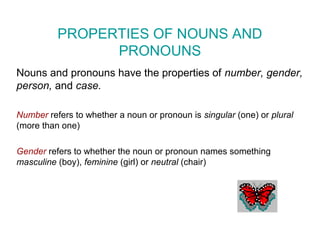Properties of nouns and pronouns
•Als PPT, PDF herunterladen•
2 gefällt mir•11,135 views
Nouns and pronouns have properties including number, gender, person, and case. Number refers to singular or plural, gender refers to masculine, feminine or neutral, and person refers to the speaker or subject. Case tells the use of a noun or pronoun in relation to other words. An appositive is a noun that follows and identifies another noun. Nouns and pronouns are in the nominative case when used as the subject of a sentence or as a predicate noun following a linking verb. Subject pronouns in the nominative case include I, you, he, she, it, we and they.
Melden
Teilen
Melden
Teilen

Empfohlen
Weitere ähnliche Inhalte
Was ist angesagt?
Was ist angesagt? (20)
Final demo teaching english 7 figures of speech(october 02, 2017)

Final demo teaching english 7 figures of speech(october 02, 2017)
CONTEMPORARY-POPULAR-AND-EMERGENT-LITERATURE-EDZ.pptx

CONTEMPORARY-POPULAR-AND-EMERGENT-LITERATURE-EDZ.pptx
Ähnlich wie Properties of nouns and pronouns
Ähnlich wie Properties of nouns and pronouns (20)
Mehr von MrsSevCTK
Mehr von MrsSevCTK (20)
Soc studies #19 gw2 revolutions, treaties, and rebellions

Soc studies #19 gw2 revolutions, treaties, and rebellions
Soc studies #17 bill of rights and preamble vocabulary

Soc studies #17 bill of rights and preamble vocabulary
Properties of nouns and pronouns
- 1. PROPERTIES OF NOUNS AND PRONOUNS Nouns and pronouns have the properties of number, gender, person, and case. Number refers to whether a noun or pronoun is singular (one) or plural (more than one) Gender refers to whether the noun or pronoun names something masculine (boy), feminine (girl) or neutral (chair)
- 2. • Person refers to the speaker of a statement in relation to the subject. – First Person = The subject is the speaker • I read that story last week. • We will arrive at 7:00. - Second Person = the one spoken to - You are very kind. - Mary, come help us. - Third Person = the person or thing spoken about Kelly ate those hot peppers. Vermont is a beautiful state. * Case tells the use of a noun or pronoun in relation to other words in the sentence. The three cases of a noun or pronoun are: nominative, objective, and possessive
- 3. APPOSITIVES •An appositive is a noun or noun phrase that follows another noun and identifies the first noun. •A noun in apposition has the same person, number, gender and case as the noun it explains 1. Willow, Mrs. Severino’s cat, is very active. 2. My sister Bernadette is a pediatric nurse. 3. Gnocchi, a dense pasta, tastes delicious. 4. Mrs. Severino’s wedding gown was made by Mrs. Lange, an excellent seamstress. Pg. 354
- 4. NOUNS AND PRONOUNS IN THE NOMINATIVE CASE * In the nominative case, a noun or pronoun can be used as the subject, or as a predicate noun (subjective complement) •The subject of a sentence is the person or thing that does the action •1. Stella rearranged the furniture. • (WHO REARRANGED?) •2. Last week, Anita rescued a cat from the tree in our yard. • (WHO RESCUED?) •3. Tony’s youngest sister is my best friend. • (WHO IS MY FRIEND?)
- 5. • A predicate noun is a noun or pronoun that follows a LINKING VERB (most often a BEING VERB). • A predicate noun RENAMES the subject – Sally is a nurse at Frankford Hospital. • (IS WHAT?) – Albert Einstein was a genius. • (WAS WHAT?) – Philadelphia is the largest city in Pennsylvania. » (IS WHAT?) • * KNOW THE BEING VERBS: is, are, was, were, am, be, being, been – FYI: A predicate adjective is an adjective that follows a linking (being) verb and describes the subject. Since both predicate nouns and predicate adjectives refer to the subject, they are called subjective complements.
- 6. SUBJECT PRONOUNS used in nominative case SINGULAR | PLURAL FIRST PERSON - I | we SECOND PERSON - you | you THIRD PERSON – she, he, it | they
- 7. SUBJECT PRONOUNS used in nominative case SINGULAR | PLURAL FIRST PERSON - I | we SECOND PERSON - you | you THIRD PERSON – she, he, it | they
